Chef Stephanie Izard is a major force in the Chicago culinary world and it doesn’t take a genius to figure out why. Every time I have tasted her food—in a booth at a food fair, at a wine tasting, in a restaurant—it has been fantastic. No doubt she excels in many of the skills that it takes to be a successful restauranteur, but none of then could possibly exceed her ability to create and serve outstanding dishes.
Born in Chicago, she actually grew up in Connecticut before going to school in Michigan and Arizona, finally returning to Chicago to work for several great chefs. She opened her first restaurant, Scylla, primarily focused on seafood, in 2004. She closed Scylla in late 2007 and went on to win Season 4 of Bravos Top Chef competition in 2008. In 2010, she partnered with the Boka Restaurant Group to create The Girl and the Goat, which was an instant hit, garnering numerous awards and award nominations. It features an eclectic menu in a casual setting. That led to The Little Goat, an upscale diner, in 2011 and Duck, Duck, Goat, Chef Izard’s take on Chinese food. Finally, in April of last year, she opened Cabra Cevichería on the rooftop of the Hoxton hotel, which brings us to this post.
The menu at Cabra is based on Peruvian cuisine, which is a favorite of mine. Cabra means “goat” in Spanish. You may have noticed “goat” in the name of all of her restaurants. Apparently the name Izard pronounced as it would be in French, is similar to the French word for a type of mountain goat, although I haven’t been able to track down the exact word or type of goat.
This was our first excursion into the world of virus-restricted dining. The rooftop setting was perfect for social distancing, fresh air and sunshine, and the sound of people talking and laughing around tables full of food and drink. It was a welcome return to something resembling normalcy.
Cabra offers a Prix Fixe Menu, a Vegetarian Prix Fixe Menu, and a la carte choices.
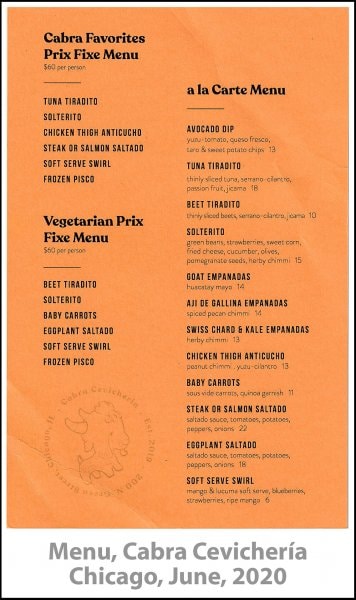
We went for the carnivore version of the tasting menu, which began with a house version of a frozen Pisco Sour.
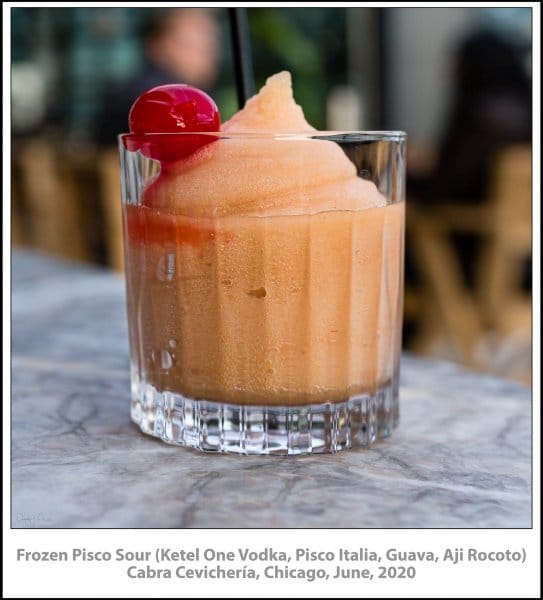
The Pisco Sour is the Peruvian (and Chilean) equivalent of the Mexican Margarita, the Brazilian Caipirinha, or a Cuban Mohito. All of these drinks feature the local distilled spirit (tequila, cachaça, and rum, respectively) mixed with lime juice, sweetened with sugar or a sweet liqueur, sometimes with an added flavor (e.g., mint in a Mojito). They could be called Tequila Sours, Cachaça Sours, and Rum Sours, but they have been given other names.
Pisco is the national distilled beverage of Peru and Chile. Both countries claim to have invented Pisco, but Peru seems to have the slightly stronger claim. Pisco is a type of brandy, which means it is distilled from fermented grape juice. A classic Pisco Sour is made with Pisco, lime juice, sugar, and egg white, whipped in a shaker or blender, then decorated with a couple drops of Angostura bitters on top. Here’s a great video with some history as well as how to make the cocktail.
The Cabra version was far from traditional, however, made with Ketel One Vodka, Pisco Italia, Guava, Aji Rocoto. Vodka is not a traditional ingredient in Pisco Sours. Perhaps it is added here to increase the alcohol content so that the drink remains slushy and doesn’t freeze solid. Pisco Italia is Pisco distilled from an aromatic grape variety grown in Peru called Italia. Guava is a tropical fruit that gives the drink it’s orange-ish color and some flavor. Aji Rocoto is a chili pepper that has been cultivated and used in Chile and Peru since before the I can Empire arose. It gave the cocktail just a touch of heat.
On the whole I prefer a more traditional Pisco Sour, but I can see how this one might appeal to a lot of folks prefer brightly colored, frozen, and sweet cocktails to more classic formulations. It was tasty, but it was also very well frozen and difficult to drink through the straw.
The first solid course was a Tuna Tiradito.
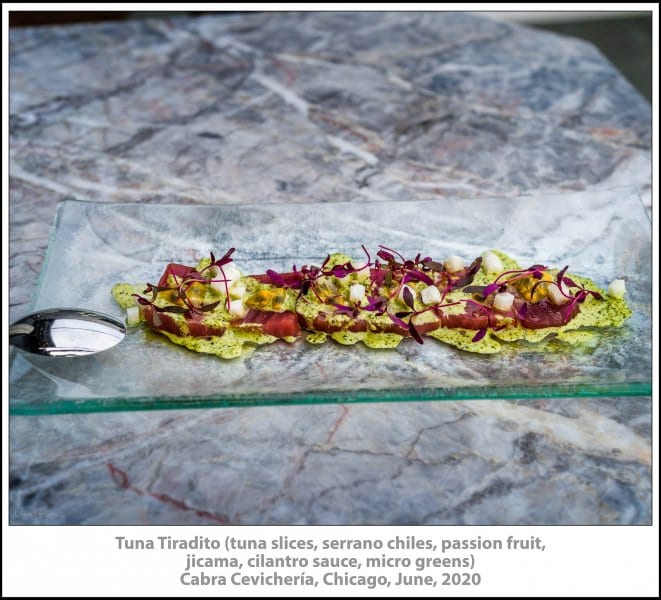
Peruvian cuisine has a lot of influences from the large Japanese population that began migrating there in the late 1800s. A tiradito is made with sashimi-style raw fish in a spicy, citrusy sauce. Variations are endless, but impeccably fresh fish, chiles (very commonly the native aji amarillo, or yellow chili), and lime juice are the core ingredients. From there, garlic, fruit, vegetables, and herbs are added as desired by the chef. In this case, Serrano chiles supplied the heat, passion fruit some sweetness and color, jicama some crunch, cilantro its own, unique flavor, and micro greens added color, texture, and pops of flavor. This was a beautiful and delicious interpretation of the dish.
Next up: Avocado Dip and chips.
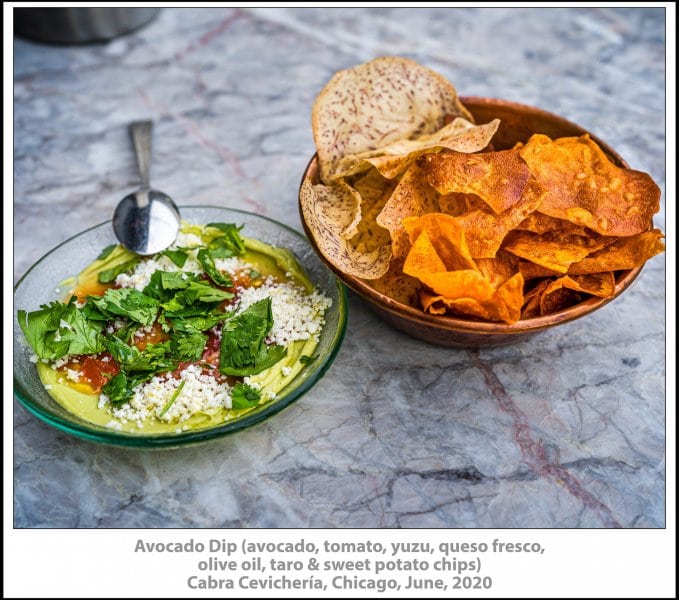
Guacamole was invented in Mexico. That is also where avocados first developed, so that makes sense. By the end of the 20th century, however, those green fruits with the big pits had become popular around the world. Variations on mashed, flavored avocados flourished. Cabra’s take on Avocado Dip blended the fruit until smooth, flavoring it with yuzu (a Japanese citrus fruit similar to, but more sour than, limes and lemons) and olive oil. Topped with fresh tomatoes and queso fresco (“fresh cheese,” a mild, crumbly type of cheese from Mexico which, as the name implies, is not aged) it was a perfect dip for the house-made sweet potato and taro chips. (Taro, like potatoes, is a starchy root vegetable.) I think the greens on top included some cilantro and Mexican epazote, but they weren’t identified and I forgot to ask.
The chips and dip were followed by a stunning salad course called Solterito.
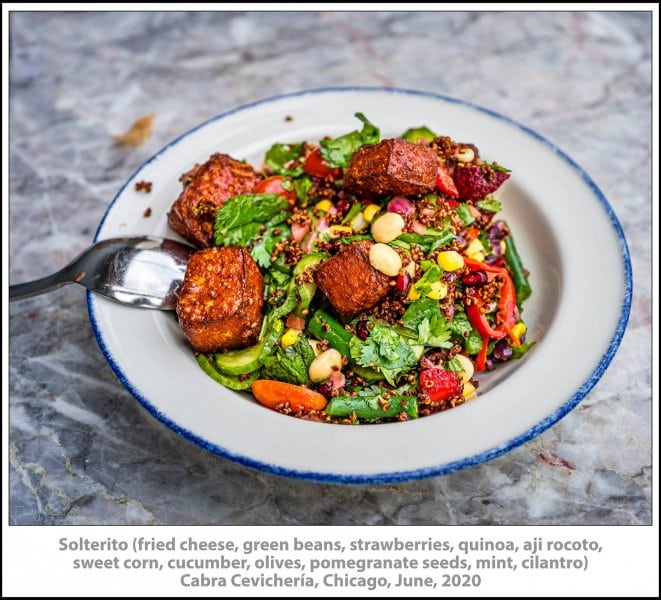
Solterito is a Peruvian chopped salad which, like tiradito, has endless variations. Traditionally, the base ingredients are fava beans, queso fresco, chilis, tomatoes, and choclo, a large kernel corn that has been part of the Peruvian diet for thousands of years. However, the fruits, vegetables and other ingredients are only limited by what’s available and the cook’s imagination. At Cabra, they chose to fry the cheese (everything is better fried). Fava beans are hard to get fresh, so green beans filled in here. Similarly, choclo is hard to get fresh in Chicago, but we have plenty of sweet corn. Then add strawberries, quinoa, cucumber, olive, pomegranate seeds, mint, cilantro, and the same aji rocoto that spiced up the frozen Pisco Sour that started the meal. The combination of flavors and textures was just amazing.
Anticuchos are a popular street food and appetizer in Peru that is simply marinated meat that has been grilled on a stick.

One of the most popular variation is Anticuchos de Corazón, or beef heart anticuchos. Heart is not a popular dish in the US, however (even though it can be delicious!), so chicken thighs were used here, flavored with peanuts, chimichurri (the famous Argentinean herb, olive oil, and garlic sauce), yuzu, and cilantro. Another wonderfully flavorful dish.
By this time our frozen Pisco Sours had gone dry, so we ordered a traditional Pisco Sour to finish the meal.
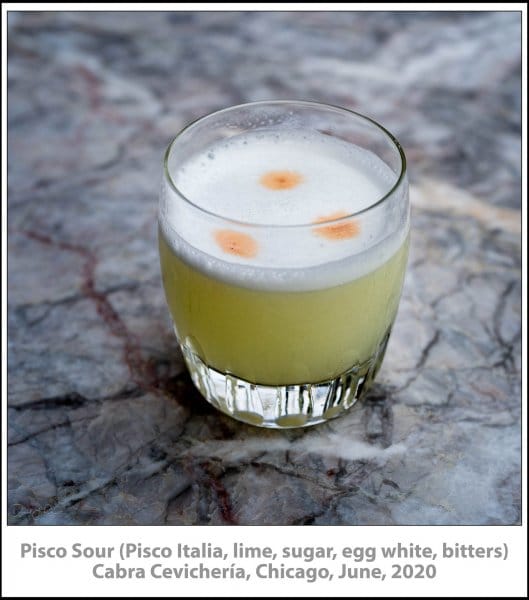
I have probably had hundreds of Pisco Sours in Peru and Chile. They vary a bit depending on the type of Pisco used and the amount of sugar added, but I could easily have been sipping this one in Lima or Santiago.
Another iconic Peruvian dish is Lomo Saltado. It is a stir fry made with strips of beef, onions, tomatoes, soy sauce, and (usually) chiles and served with rice or French fries.
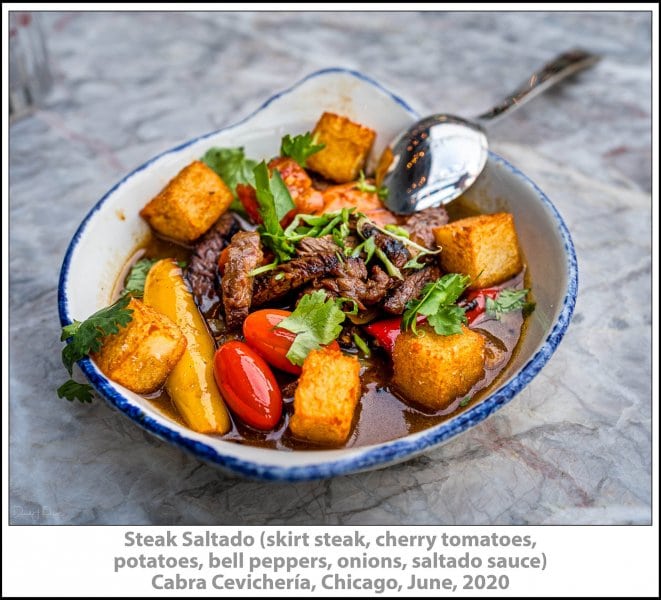
Cabra’s version was largely traditional, with diced, fried potatoes in place of fries or rice. The broth was deeply flavorful.
Finally, dessert.
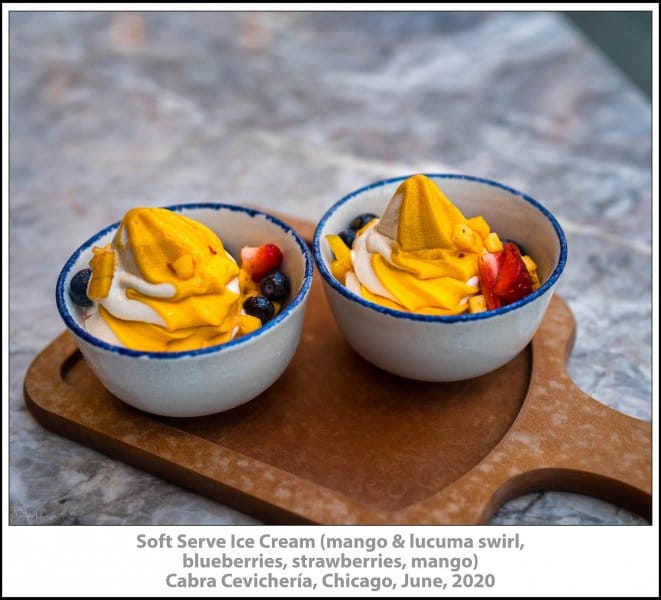
Desserts tend to be pretty simple in Peru. A little fruit and/or ice cream are common. Here we have exactly that in the form of two soft serve ice creams with fresh berries and mango on top. You are probably familiar with mango, which is fairly common in the US (though it can be hard to find a nice, ripe, fresh one).
Lucuma is the fruit of an evergreen tree that is native to the Andes mountains of Peru, Ecuador, and, to a lesser extent, Chile. It has proven difficult to grow in other regions, but it has been a favorite of people living where it grows going back to pre-Inca times.
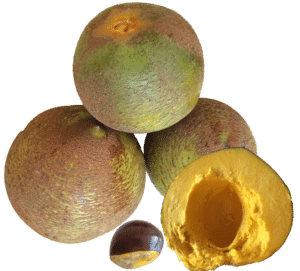
The lucuma fruit is quite sweet, but has an odd mealy texture when served fresh. It is far more commonly preserved in syrup or used to flavor ice cream, cakes, and other desserts.
Chef Izard does not claim that Cabra serves authentic Peruvian cuisine and that is fair, mostly because some of the most characteristic ingredients, such as Aji Amarillo and choclo, are not readily available fresh in Chicago. However, the food most certainly captures the ideas as well as many of the aromas and flavors behind the original versions of the dishes that appear on the menu. As I have pointed out, all of the dishes on the menu are made in endless variations in Peru itself, so there is no exact, “authentic” recipe. Lima, Peru is one of the most dynamic and diverse food cities in the world, and I suspect that Cabra would be more than welcome if they decided to setup shop there.
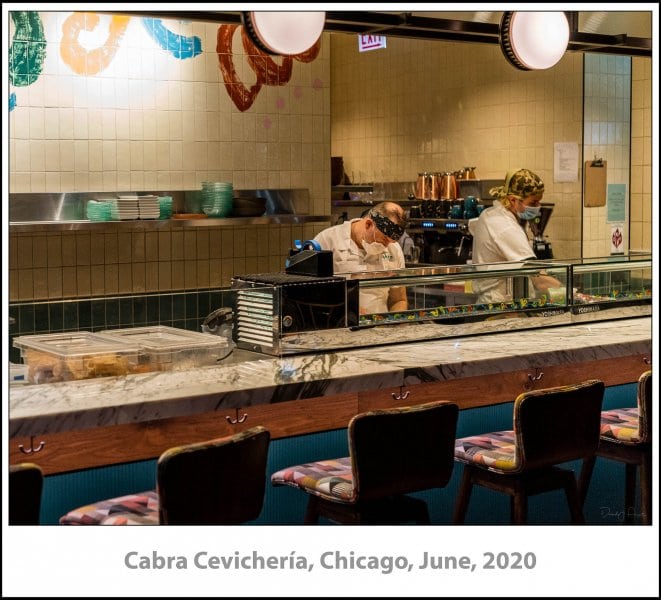
So, we were very happy to be able to dine out in a somewhat normal manner with excellent food and drink. Yes, the masked waiters, widely spaced tables, and other safety precautions take a little getting used to, but the overall experience was great. I hope many more restaurants are able to open safely and successfully in the weeks to come.
Cabra Cevichería (on the rooftop of the Hoxton hotel)
Address: 200 N Green St Chicago, IL 60607
Phone: (312) 761-1717
Reservations: opentable.com
Website: https://www.cabrachicago.com
Dress Code: Smart Casual
Price Range: $31 to $50
Hours: Brunch: Saturday—Sunday 12:00 pm–3:30 pm
Dinner: Monday–Friday 4:00 pm–10:00 pm
Saturday—Sunday 12:00 pm–10:00 pm
Credit Cards: AMEX, Discover, MasterCard, Visa
200 North Green Street, Chicago, Illinois
The author has no affiliation with any of the businesses or products described in this article.
All images were taken with a Sony a9 camera with a Zeiss Batis 40mm f/2.0 CF lens using ambient light. Post-processing in Adobe Lightroom® and Adobe Photoshop® with Nik Collection by DxO and Skylum® Luminar® plugins.




